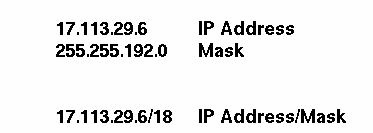IP Address
An IP network address is 4 octets (32 bits) long with the left-most
bits defining the subnetwork part of the address and the remaining bits
defining the host or station portion.
The number of bits for each portion is not fixed, so an IP address
must be accompanied by a mask that specifies the subnetwork
segment of the address.
An IP address is typically displayed by using a decimal value for
each of the octets, separated by periods.
The associated mask is sometimes represented in the same format, or
it may just be shown as a decimal value for the number of bits to be used
for the network portion of the address.
Figure A.4 shows the different formats.

Figure A.4: Sample IP Addresses
In the netWorks application, IP addresses are specified as
four integers separated by periods, and masks specify how many of the
integers to use for the network portion of the address.
Therefore, a mask has a value of either 1, 2, or 3.
Copyright © 1999 by SAS Institute Inc., Cary, NC, USA. All rights reserved.
